THE CHOP'S LAST STAND
Surviving a shooting and standing at the front lines as Seattle's no-cop zone came to an end.
Welcome to RAVE NEW WORLD, a newsletter on the intersecting futures of drugs, nightlife, and the new political counterculture. Today, I attempt to recap of the messy final era of the CHOP, where I’ve been hanging out for the last week—embedding with protestors and witnessing the shooting that precipitated the police shutdown earlier this week. It’s tough to untangle the web of conspiracy theories and disinformation surrounding this zone, but here’s what I know from my time on the ground. This newsletter is only possible thanks to paid subscriptions—you can support this work by upgrading to a paid subscription tier, or sharing this post with your friends on social media. Thank you!
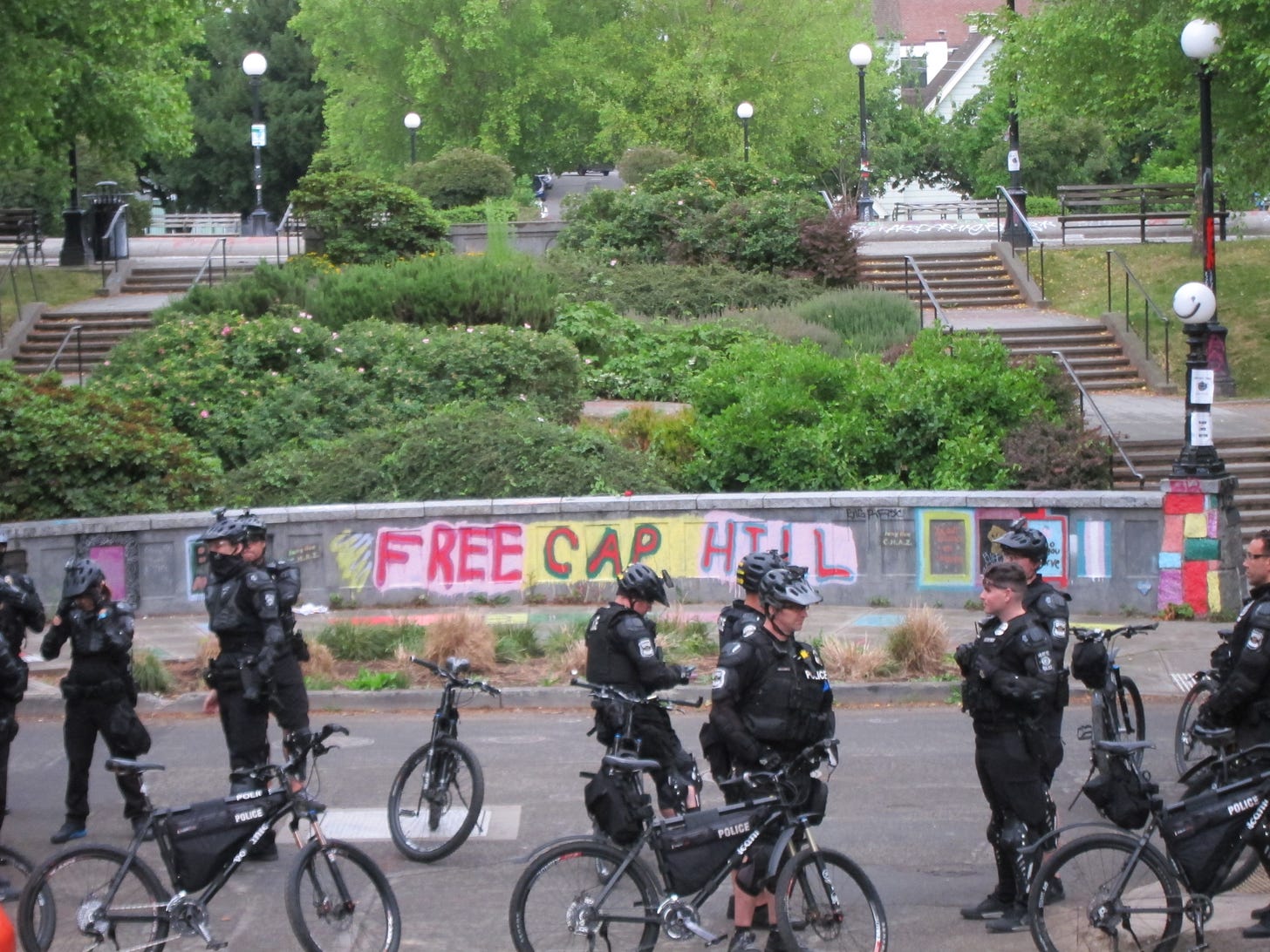
When I landed at the CHOP last week, it felt like I was pulling up to a party for its final hours, when just the druggies and diehards are left on the dancefloor. This twilight stage is often my favorite, for it can be the freakiest part of the night, or the darkest and most pathetic—either way, it’s always a trip. On the final week of the CHOP, its bustling farmers’ markets, impromptu rock concerts, and lively conversation cafe had faded, and the only traces of its jubilant early days were colorful murals and angsty graffiti splashed on every surface. Protestor numbers had dwindled after multiple shootings, and even the antifa security forces were giving up their posts. “It’s like you’re eating the crumbs at the end of a bag of chips,” one local told me, “You’re getting a sense of the flavor, but you can’t tell if it’s sour cream or dill.”
The CHOP has always been an amorphous beast, however, and with mainstream news cameras mostly departed from the scene, it was mutating into wilder forms under the cover of darkness. My first night at the CHOP was a chaotic whirlwind; when I returned last Saturday evening, a group of kids tossed me a bag of shrooms, and I spent the night patrolling with antifa security and medics, watching them de-escalate endless dumpster fires of tense situations (more on that in a future newsletter 0.o). On Sunday, I decided to pull an all-nighter in the zone with a friend named C, who volunteered to be my CHOP buddy in case things got hairy. Around midnight, we walked into Cal Anderson park—a leafy field adjacent to the abandoned police precinct, where about 100 protestors and houseless people were camping. Immediately, we heard angry shouting, and saw the shadowy silhouettes of people moving away from some violent eruption. “Everyone needs to chill,” breathed a guy running past us, eyes bugging. “Things can get pretty crazy at night here,” I told my friend, “Stay close.”
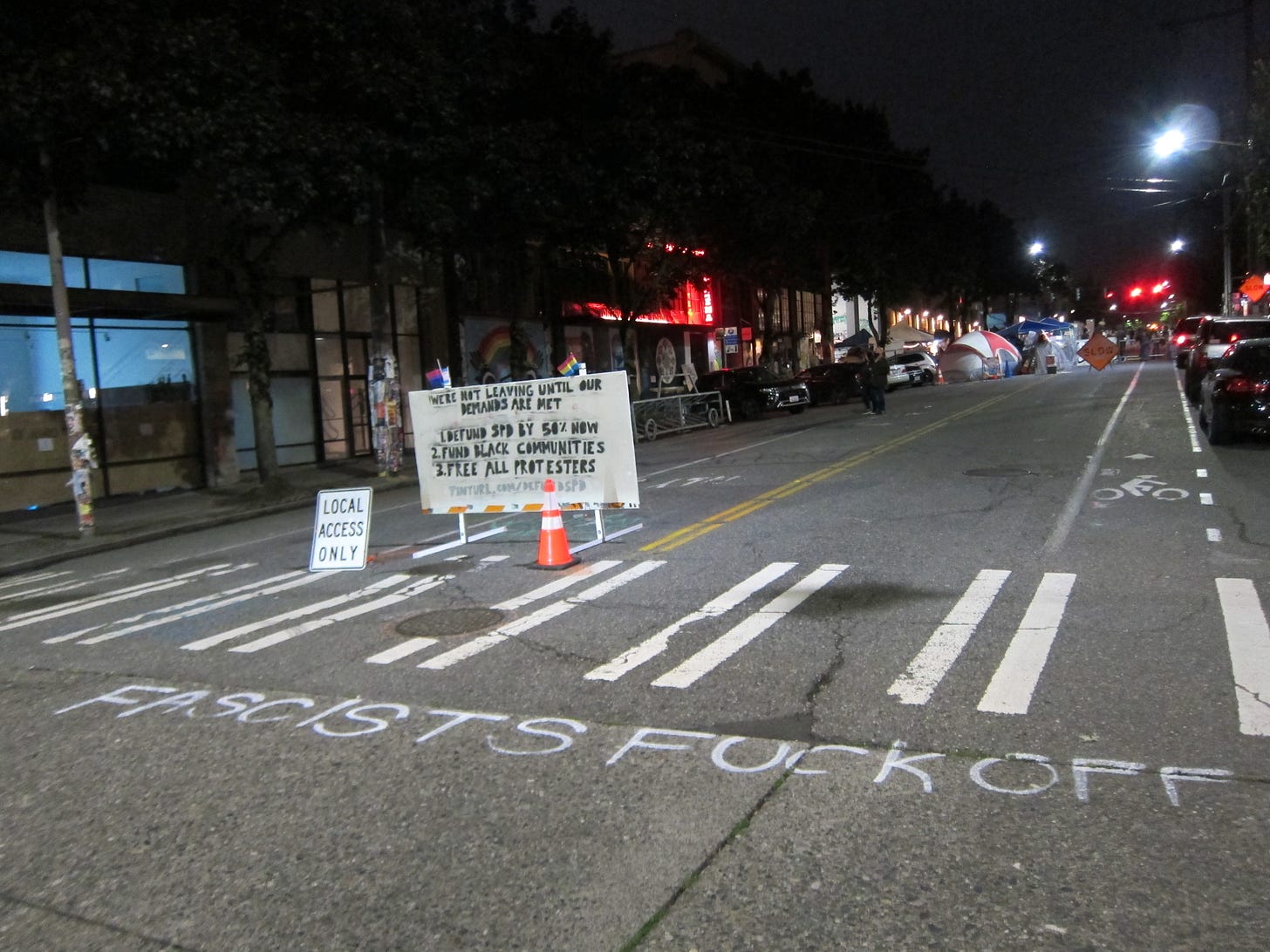
A homeless woman wandered up. “I can’t wait to get out of this hellhole,” she said with a toothless grin, then pointed straight up to the sky. “But look up—you can see the Big Dipper.” We tipped our chins to the sky, but our stargazing was cut short by screaming. “Get down, there’s a gun!” someone shouted. Whipping around, I saw a white car speeding across the field. Everyone scrambled to take cover, and I dashed from a foldout table to a tent. Every surface seemed too flimsy to stop bullets, and in a flash, I realized I’d never learned how to hide from a shooter. A string of fourteen shots at close range ripped through the air, then dead silence. The car had disappeared, but people were still scrambling. “Let’s get the fuck out of here,” I said to my friend, grabbing her arm as we ran away from the park and into the streets. Some people were crouched behind cars or hiding behind trailers, while others tried to take cover in the lobbies of expensive condos. Two women stood under a street light, hugging each other and sobbing.
“If you don’t have a gun, please retreat to the precinct,” one of the CHOP’s leaders was repeating over a megaphone, but it seemed like every other person was brandishing a rifle or gun. The stadium flood lights that usually lit up the field were also ominously half dimmed, drowning the streets in shadowy pools and making it impossible to see much of anything. Adrenal electricity coursing through my veins, the night warped into a surreal delirium, as strange figures stepped in and out of the shadows—including two men in power ranger suits who claimed to be medics, marching past me in search of the perps, neon helmets glinting.
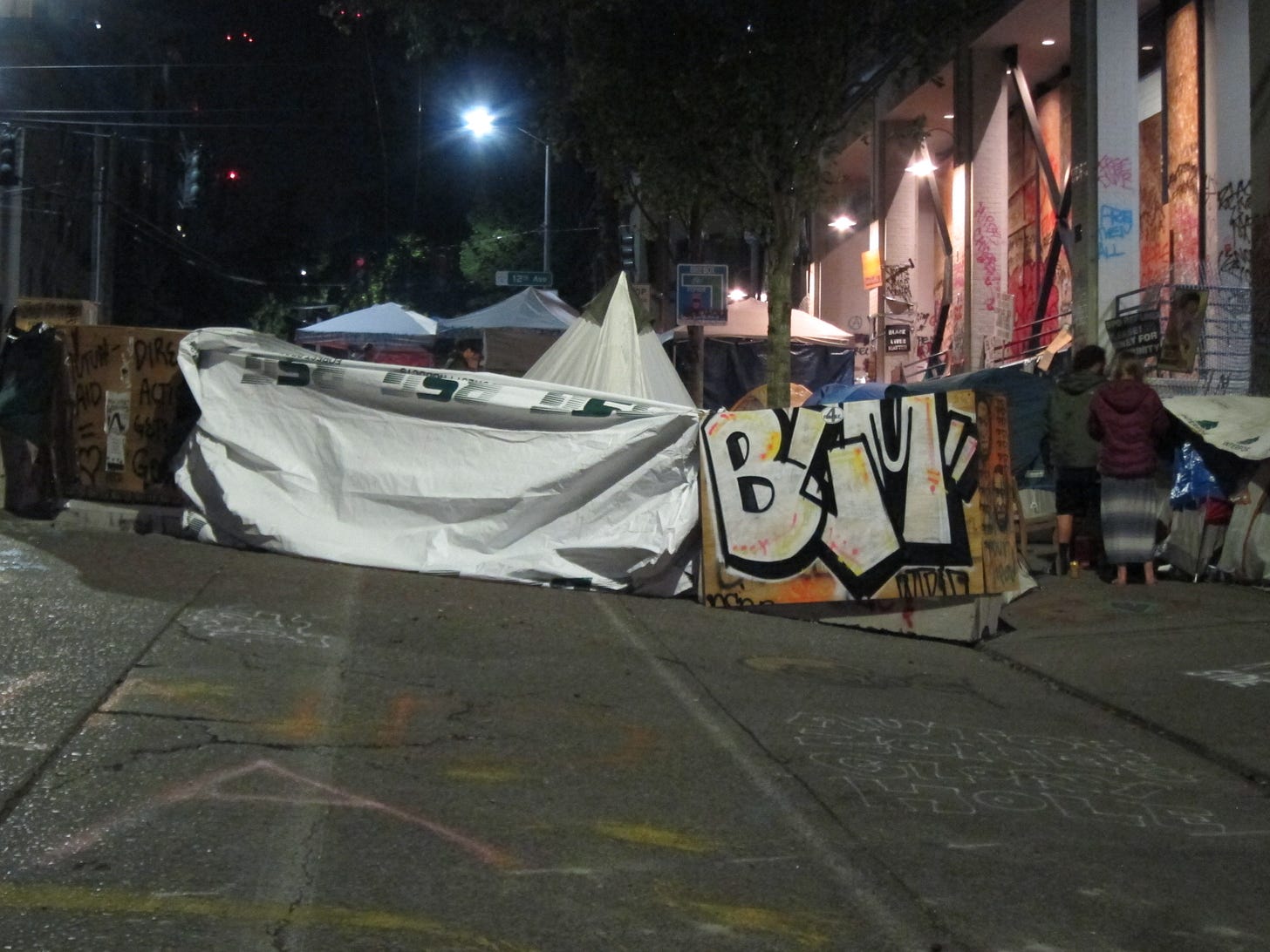

When we reached the police precinct, we were told not to worry, that nothing bad had happened—that whoever shot the gun was just shooting blanks, trying to scare people. A protestor with the alias Rad 2 Cool started walking across the grounds, spreading the news that a theater nearby had been turned into a makeshift trauma center, offering a safe place to rest and refuel to anyone who needed it. My friend and I followed Rad back into the park, where we wound up at a pop-up protest garden—a peaceful space cultivated by protestors, where revolutionary signs sat next to patches of vegetables and flowers, and water tanks were stenciled with BLM fists.
Taking a seat at a circle of tree stumps, we found ourselves in the midst of a motley crew of people: a disheveled corporate-type in a three-piece suit, a gardener smoking out of a chic black bong, a yogi carrying the holy book of Bhagavad Gita, a bushy bearded Easten European. The queen of this circle was a trans woman with bright red hair named Azzy. She turned around to greet me, gazing at me with eyes like deep wells. “I am sad—this is going to be over soon, I know it,” she said. Azzy told me she had lost nearly everything, including her home, when she transitioned a year and a half ago, and after spending the last few weeks hanging out in the garden, she was seen as a leader in this hybrid community of homeless people and protestors. “This place means everything to me,” she said, eyes welling. “It’s given me something to believe in again.”
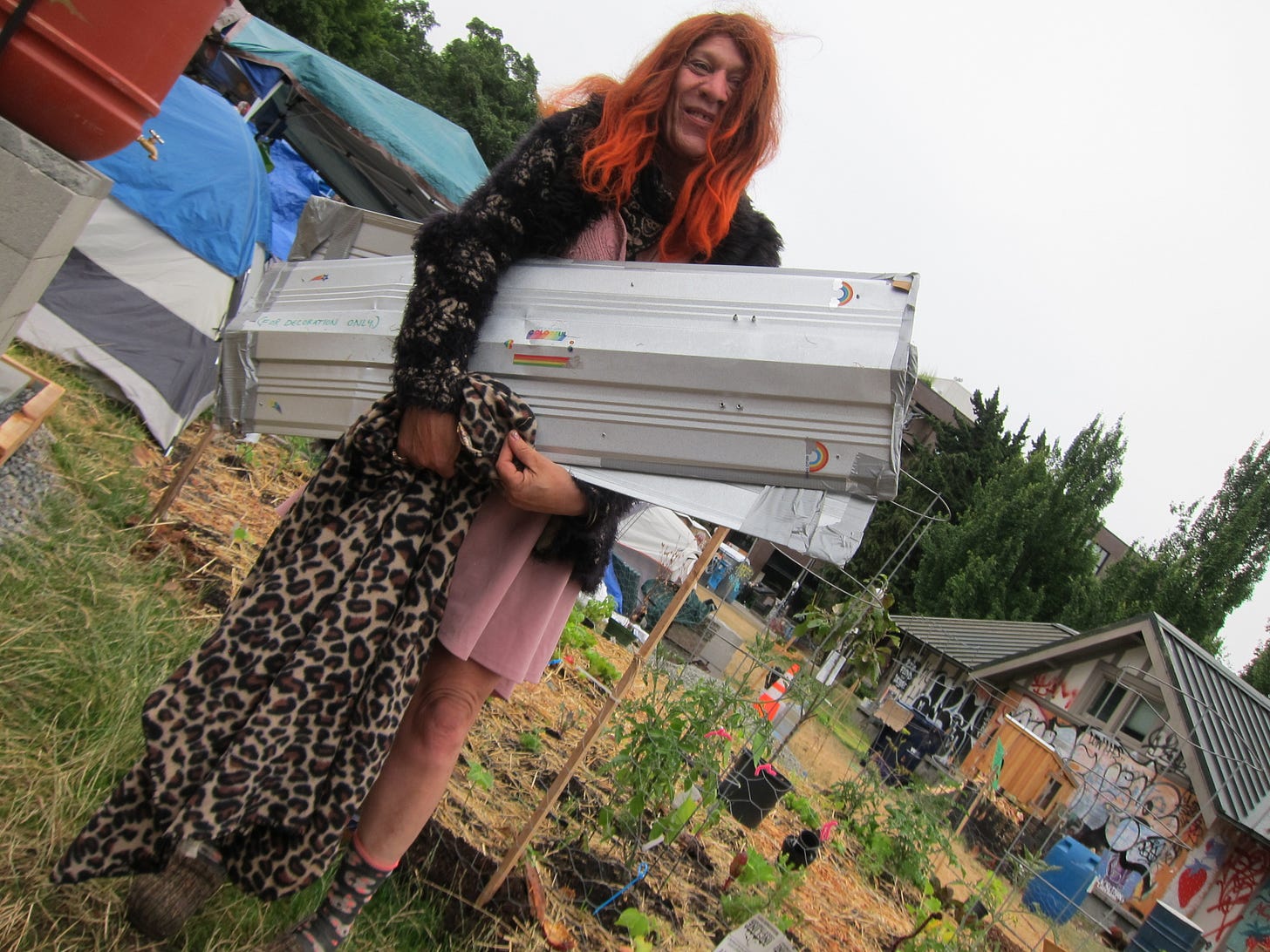
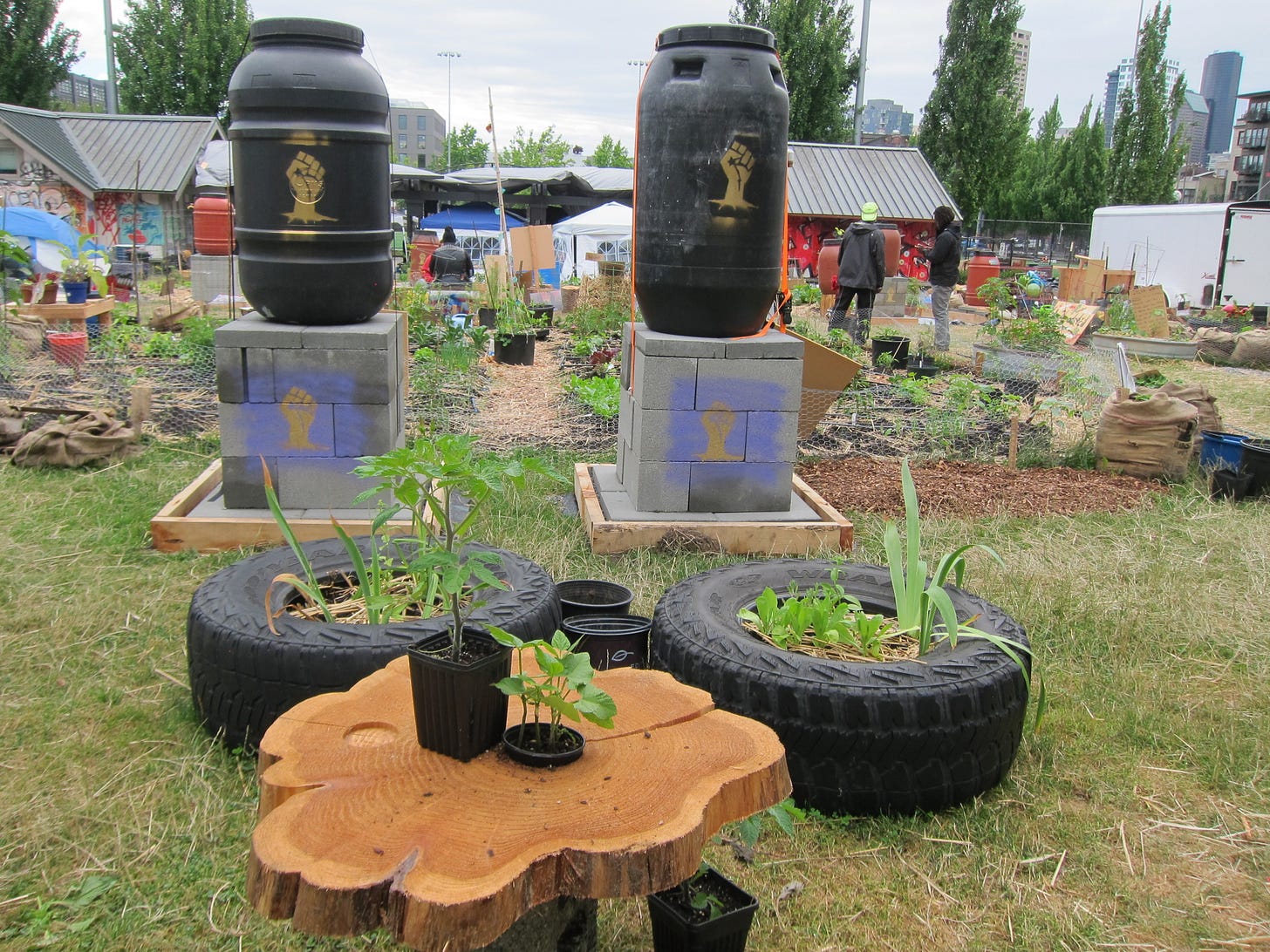
A young man in a bulletproof vest came to sit with us. He had been part of the CHOP’s security team, and broke the awful news: a sixteen-year-old kid had driven a car into the barricades and was shot dead, while the fourteen-year-old passenger was in critical condition. Protestors from the CHOP had driven one of the victims to the hospital themselves after waiting too long for the ambulance, and the crime scene was now surrounded by duct tape to preserve it for CSI. Everyone took in the news in stunned silence. Dawn was breaking, and as the sky lightened into a purple-blue, a gospel hymn floated over the garden sung by someone unseen—their powerful, honeyed tremolo washing over the field like a requiem.
Everyone agreed that the death of another young black man to gun violence was fucked, but what actually happened, and who was to blame? The CHOP is a dizzying whirlpool of disinformation, and it’s often impossible to discern fact from paranoid speculation. The dominant narrative between protestors is that these two teenagers and their friends were seen hanging out at the CHOP for the last few days stirring up trouble, and they had fired the shots and tried to ram the barricades as part of initiation rites for one of Seattle’s CD (Central District) gangs. Many people believed that the whole thing was a set-up, noting how at this and every past shooting, fireworks were always popping off simultaneously, and stadium lights that usually lit up the field were mysteriously been dimmed—fueling conspiracies that the violence was instigated by malevolent outside forces, like the Proud Boys or FBI. To add even more chaos to the situation, a separate pick-axe attack also took place right before shooting, scattering security in different directions. While media reports have alleged that CHOP security fired on these two teenagers as self-defense, thinking the car was speeding into the barricades as an attack, the CHOP has denied the shooters came from their camp.
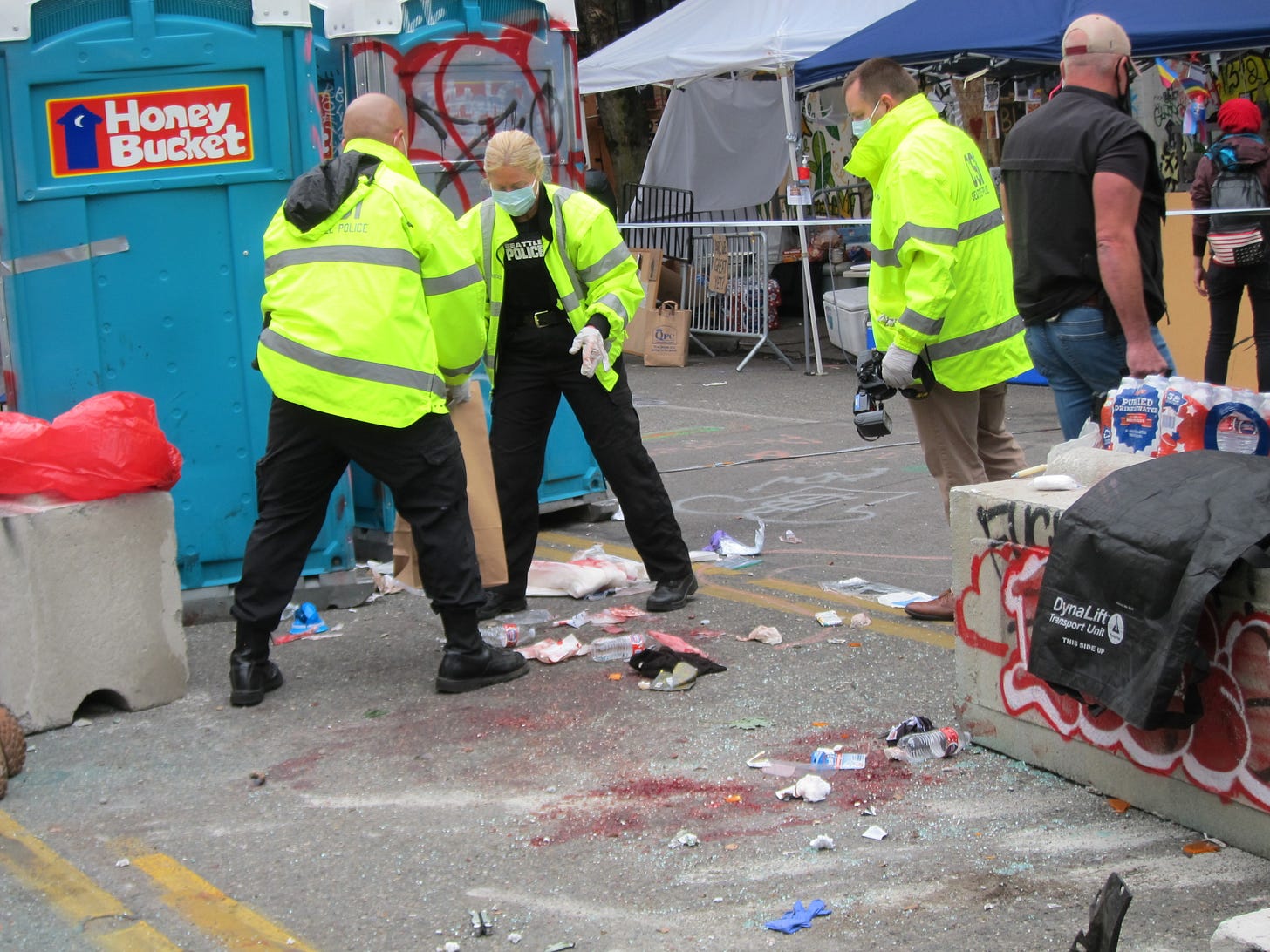
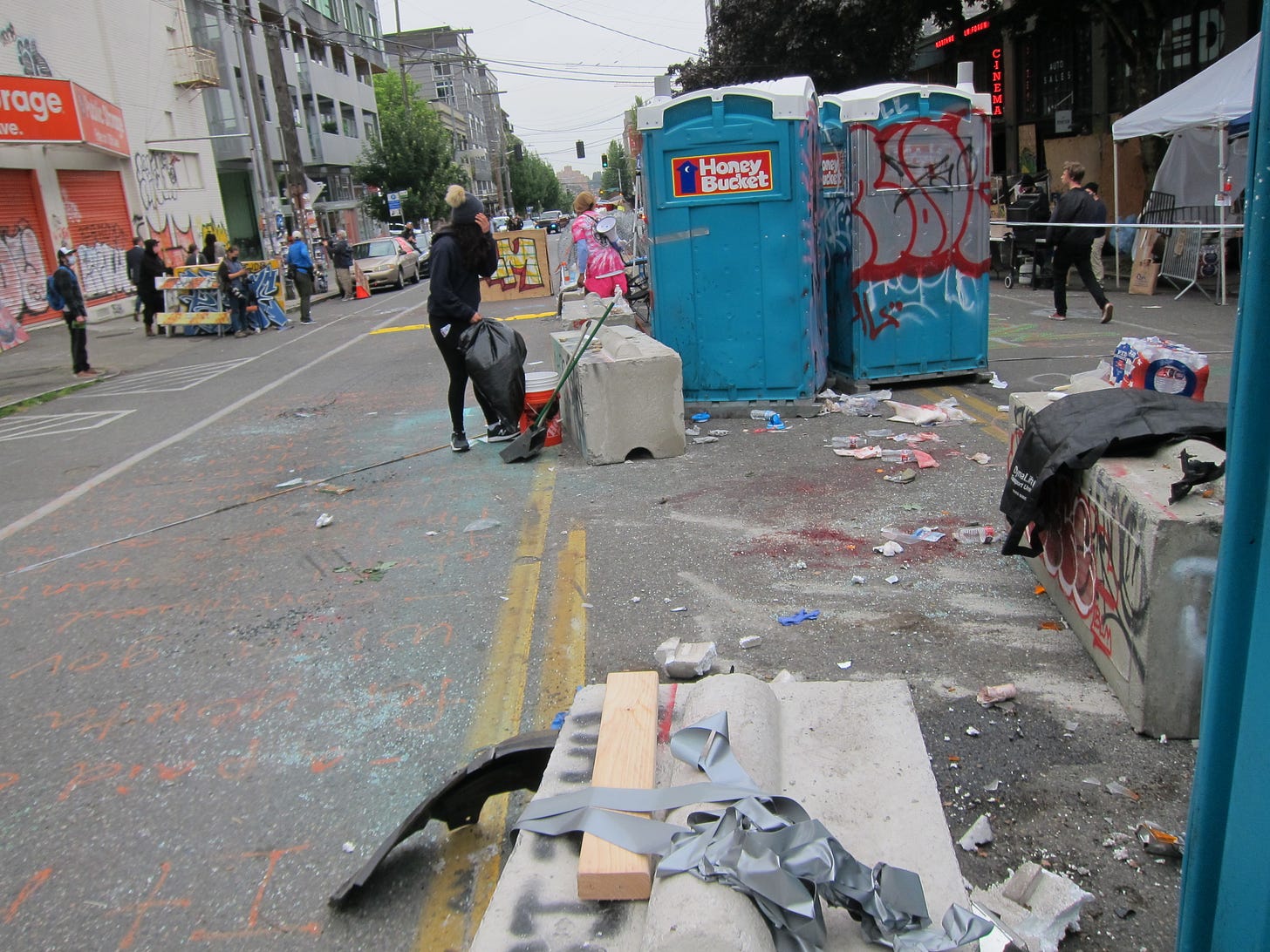
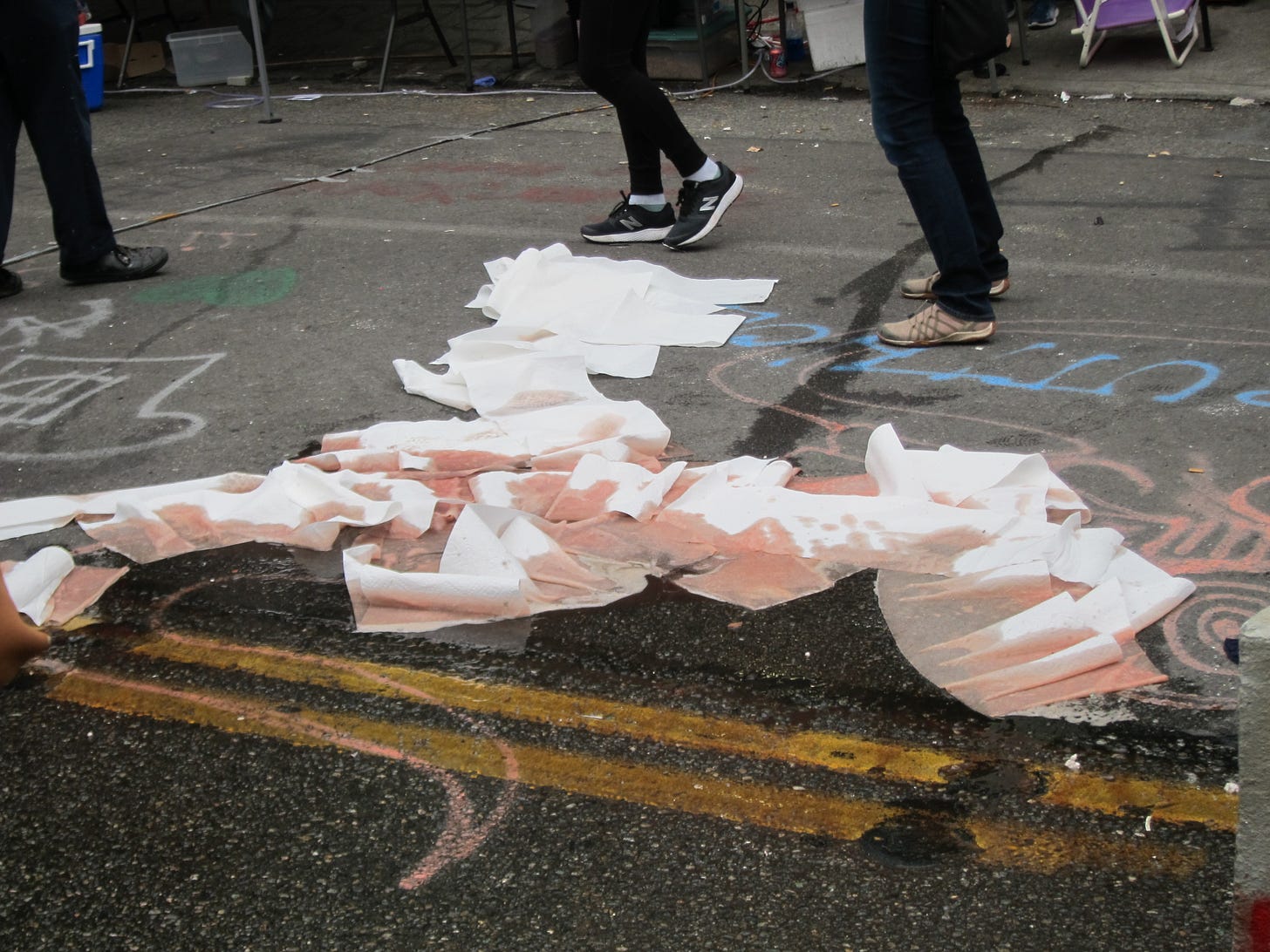
I’m not sure we’ll ever know what really happened, but I do know that we waited almost eight hours for the police to show up and investigate the crime scene—and when they did, I watched detectives take a cursory walk around the broken glass and blood, before the authorities quickly departed, leaving protestors to clean up the mess with brooms and paper towels. The mainstream news cameras showed up around this time, and tensions were flaring. When Fox News journalist Dan Springer was overheard calling protestors “filthy,” a CHOP leader next to me threw her coffee at him, and he bumped her with his chest, sneering. The scene exploded, with protestors shouting at a Black Fox cameraman for being a race traitor, while the FOX team retreated into their car. Protestors surrounded Springer’s car, pounding at the windows and refusing to let them leave until Springer apologized. (They eventually fled on foot.)
Meanwhile, Seattle’s Police Chief Carmen Best showed up, giving a quick speech about how “enough is enough” and the CHOP needed to be dismantled. When I heard Best was doing a media appearance, I grabbed one of the CHOP’s leaders and we sprinted to talk to her—but she had already left, less than fifteen minutes after arriving, with no attempt at negotiation.

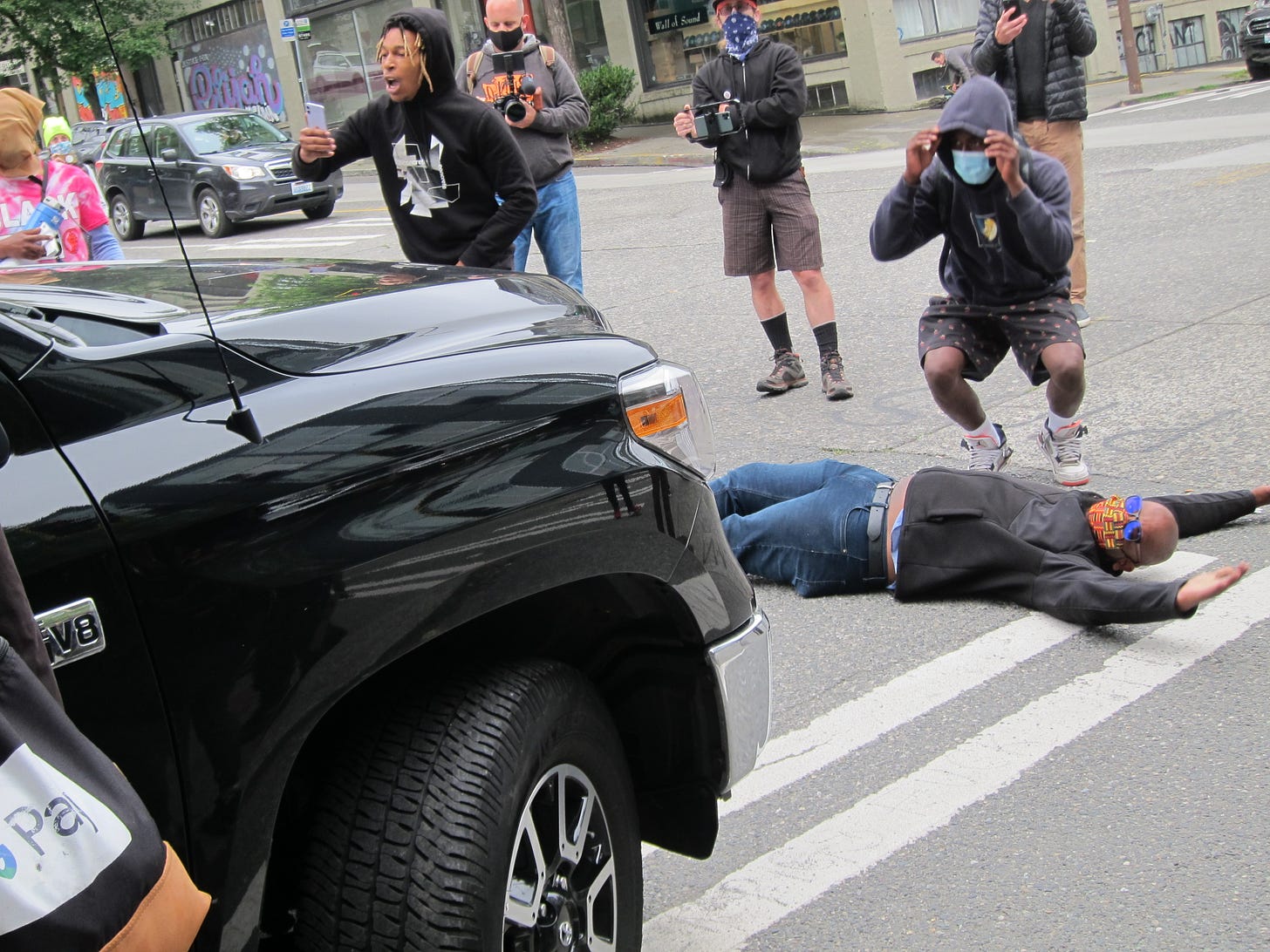
The next morning, the sky was grey and the energy felt subdued, as if stoned. The CHOP’s numbers were shrinking, and reams of negative press around the latest shooting had overwhelmingly turned the court of public opinion against the protestors, who were being blamed for the violence. Nationwide pressure for Seattle’s Mayor to shut shit down had reached a boiling point—even Trump was tweeting about it—and city workers showed up with forklifts to remove the concrete barricades that had been guarding the CHOP’s perimeters. I found Azzy smoking a cigarette in her tent that afternoon. “Now it’s just a war of attrition,” she said, telling me that city workers had also removed the area’s porta-potties that afternoon. She showed me a basket of homemade defense weapons she had been collecting over the past few weeks—a bicycle helmet, scrap metal turned into a shield, a makeshift bow and arrow. “It’s time to fight, but I don’t know if I have any fight in me left,” she said.
Later that night, I stumbled into a random tent in a quest to look for weed, which is how I met a protestor named X who told me a story that changed the game. According to X, the two teens who rammed the barricades on Sunday were his friends—he’d fed them their last meal. X described his friends as “hyphy,” and said those teens had gotten into a fight that night and someone had pulled a gun on them. X claimed the teens decided to steal a car to run away, and wanted to head downtown, but didn’t really know how to drive and ended up making a wrong turn, crashing into the barricades by accident. X also claimed there was a third person in the car—a friend who escaped after the crash and had this inside story to X. If X was telling the truth, this shooting wasn’t the result of a gang initiation, or a planned FBI attack, or any other theory that would give this tragedy a clear reasoning—instead, it was just another senseless loss of a young black life to gun violence that will likely never be solved by the indifferent police.
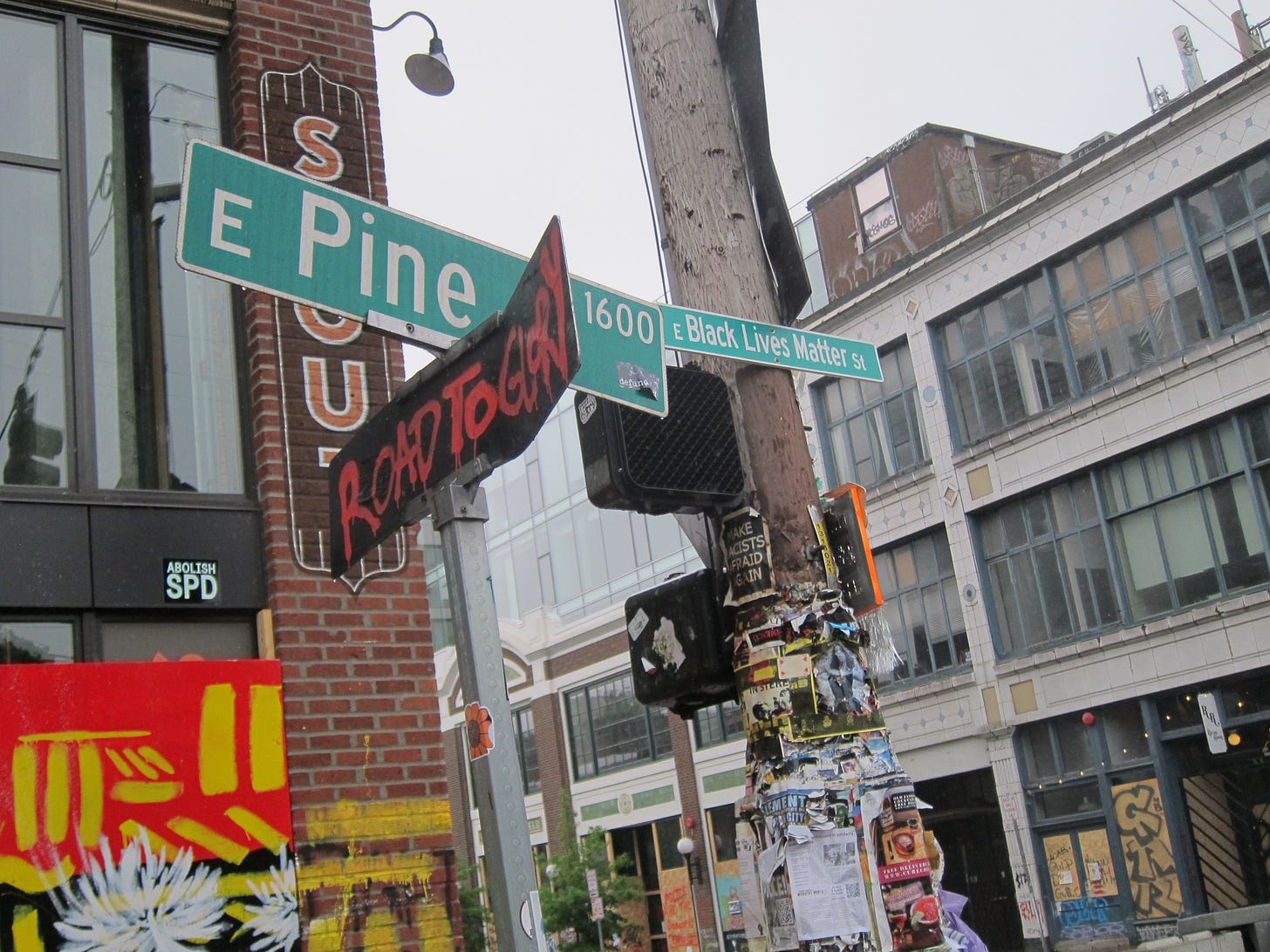
When I left the CHOP on Tuesday night, I took a long look around the zone. There were just a few dozen people left, and with no more fights or dramatic episodes, the night air felt calm and peaceful. A few security guys stood chatting at the borders, where a makeshift barricade had been constructed out of furniture and plywood planks. “Why do you think I’m still here? I’m trying to die,” I heard a girl’s voice float out of a tent. “Go die somewhere else,” a man retorted.
Then, at 5am on Wednesday, I jolted awake to the adamant buzz of a phone call. “We need people to defend the precinct right now!” yelled a protestor named Tinae on the line. “The police are here, beating and pepper spraying us. Please come help us, and tell everyone you know!” Leaping from bed, I sprinted to the scene with a sinking feeling in my stomach. Of course the cops would choose this freezing cold, rainy morning to dismantle CHOP, when no media would be around to document it. It turned out that at 4AM, Mayor Durkin had issued an executive order declaring that the CHOP constituted an “unlawful assembly,” which set the legal grounds for the cops to move in.
I arrived to a line of police standing at the entrance to the CHOP, holding up bicycles to create a barricade. No one was allowed in, not even press, and if you crossed the barrier, you would be arrested—as several protestors did. Inside the zone, police were sweeping the area of both protestors and homeless encampments, while breaking back into their precinct with hoots and cheers. “They were hitting people with their batons, and saying ‘this is a dispersal order, you have five minutes to pack and disperse, or we will arrest you,’” Tinae later told me. “If you were walking backwards and you tripped, they arrested you.”
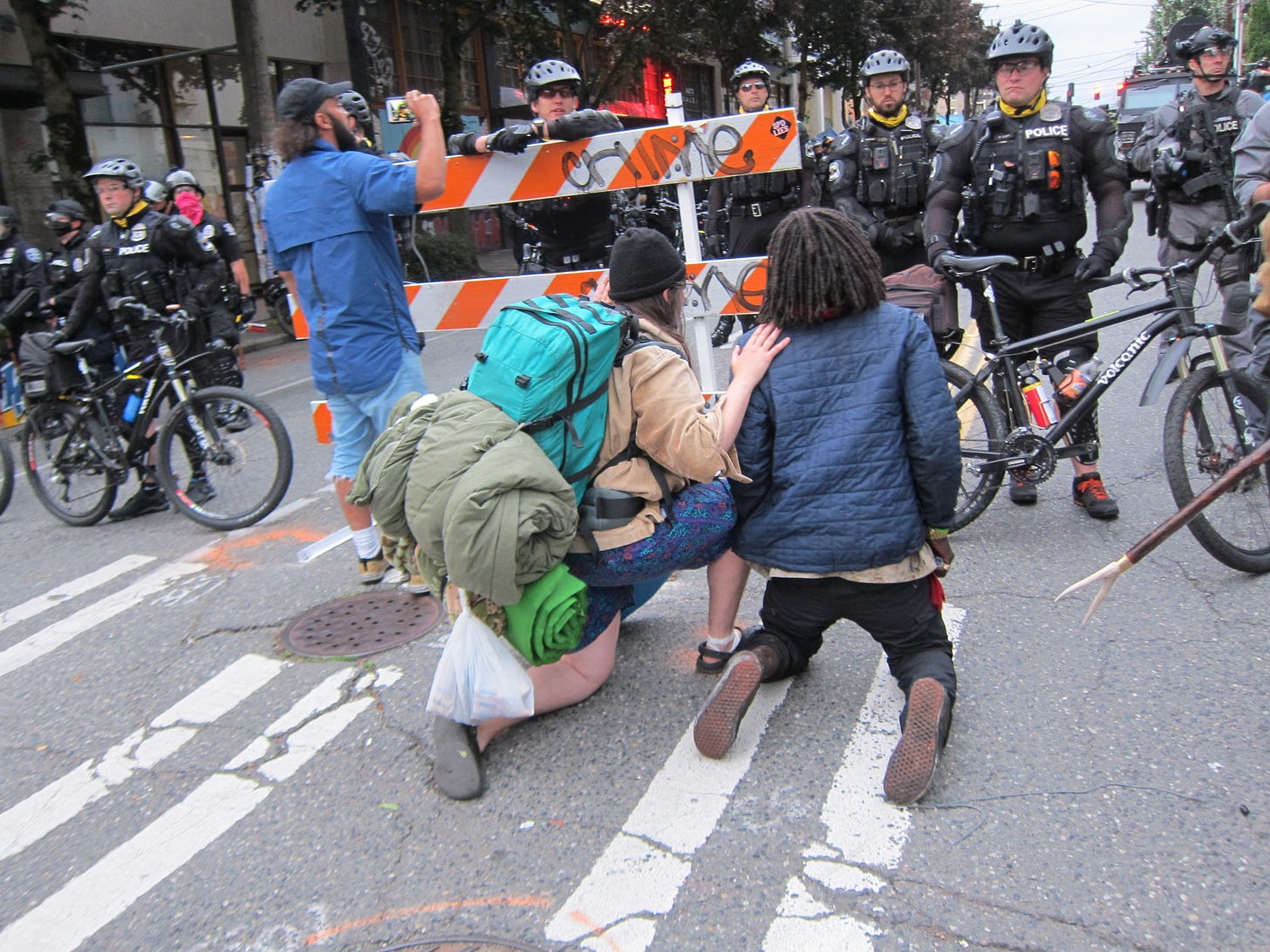
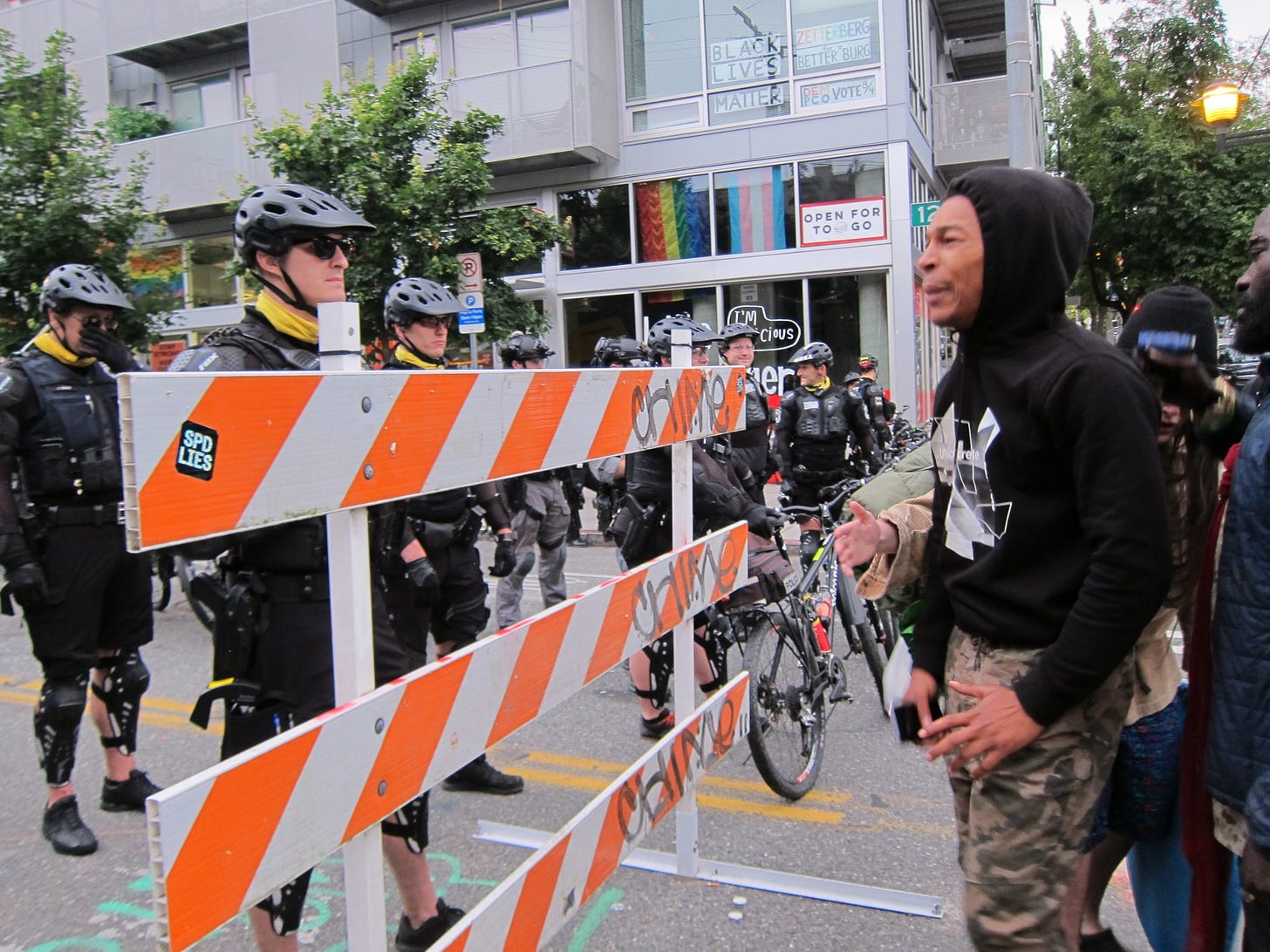
Trinae also said the protestors were supposed to have another negotiation meeting with the city later that day at 11:30 AM, but police had showed up at 4:30AM. “They just started shoving people and taking out knives, destroying tents—they didn’t give two shits if people were in there or not,” Tinae said, telling me that protestors tried to form a human barricade around the precinct, but just didn’t have the numbers. “The media makes us out to be criminals, terrorists and rioters,” she added. “They just show up and interview the wrong people who don’t have the experience to speak for CHOP.”
Perhaps the fall of CHOP was inevitable, as every temporary autonomous zone must eventually come to a close. Yet the CHOP had survived against the odds for so long, many protestors thought if they could just hang on a little longer, the city would cave to their demands just to end this drawn-out stalemate. Nobody knew the grand finale would arrive so suddenly, and that the CHOP would go out in exactly the same way that it came in: in a flash of police brutality and violence, converging into a mess of chaos and confusion with no real resolution. Will we ever make sense of the CHOP? My head is spinning with all the competing narratives and conspiracy theories, but I know there is meaning in this mess. Next week, I will attempt to untangle these theories and figure out the CHOP’s legacy—and what it all ultimately meant.
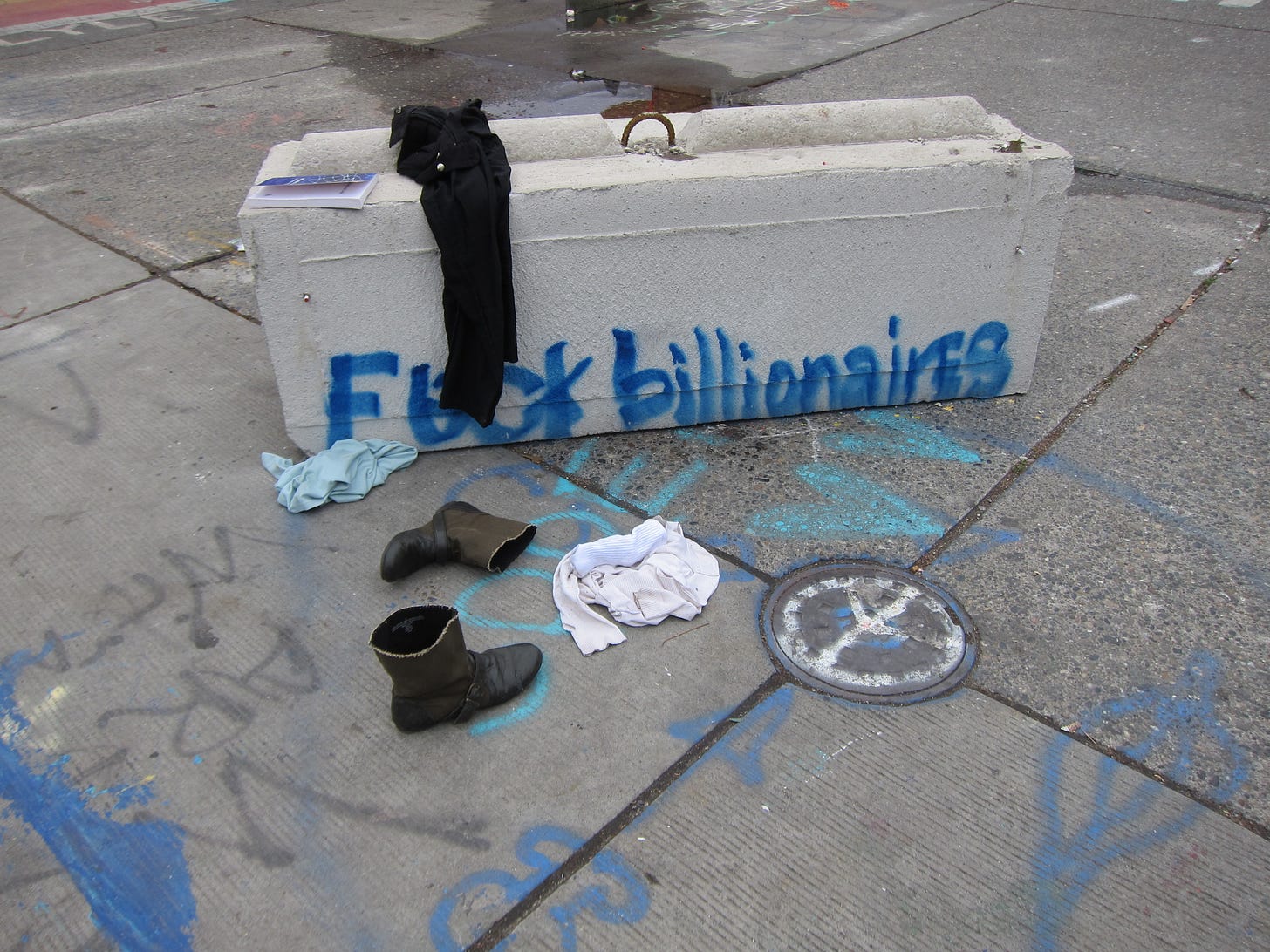
LIVESTREAMING FROM THE CHOP
Writing has always been my thing, but for the last week, I’ve been experimenting with live-streaming at the CHOP, and you can check out my footage from the shooting on Sunday as well as the cop invasion earlier this week on my Instagram.
I’ve gotten quite a few messages from friends and followers thanking me for these streams, which is super encouraging. I’d like to keep doing this—especially since the police are taking more violent crowd-control tactics post-CHOP—and I need some funding to buy better gear. (It’s a little embarrassing showing up with my cracked cellphone when all the other streamers have fancy gear, tbh) If you can, please consider upgrading to a paid subscription tier to help me upgrade my tech. Thank you for your support!

